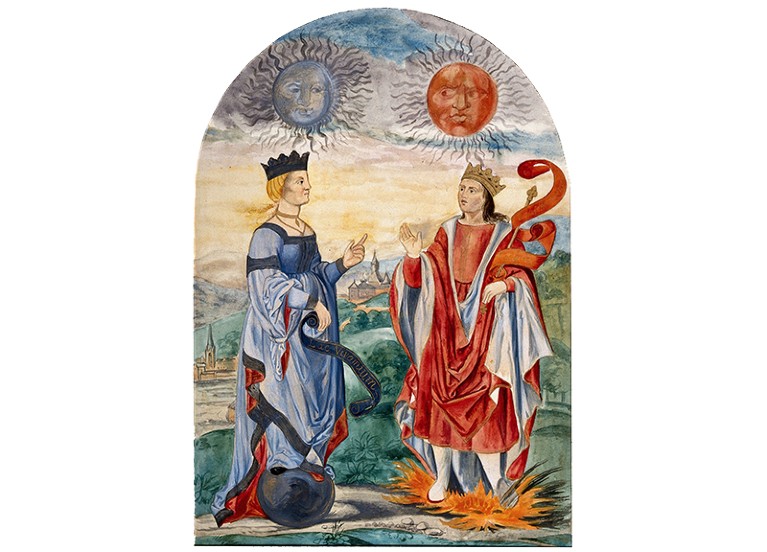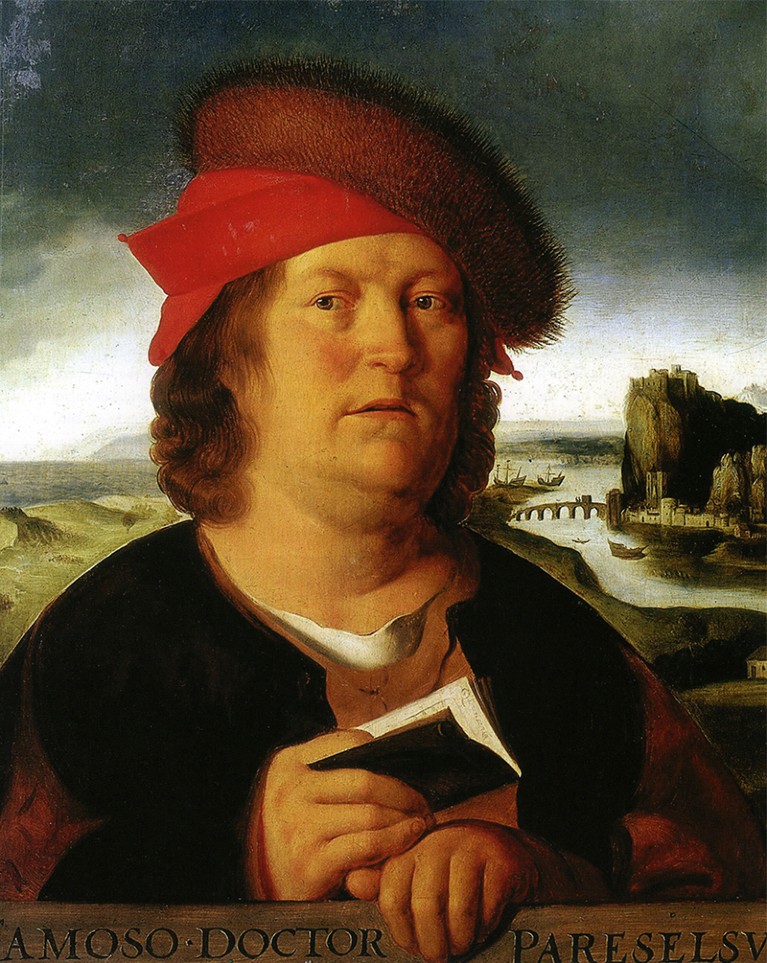
Personifications of the principles of mercury and sulfur, from the sixteenth century.Credit: Wellcome Collection
More than two millennia before the periodic table was conceived, ancient philosophers were already grappling with the nature of ‘stuff’ in the world. Are all substances reducible to the same, universal matter? If so, when exactly does one substance become distinct from another? From Greece in the fifth century bc to northern Europe in the seventeenth century, successive attempts to answer these questions gave rise to a profusion of coexisting concepts, from elements to principles, atoms to corpuscles — each intended to solve a specific problem, each raising new difficulties.
Nature special: The periodic table
In the fourth century bc, the philosopher Aristotle formulated the problem in his Physics: how many times can a piece of gold be bisected before it ceases to be gold? He intuited that there is a level of simplicity beyond which matter cannot be reduced without losing its defining character. This is the “natural minimum”: the smallest particle of a substance that can still be identified as being of that substance. Any smaller, and our example could no longer support the bundle of properties that makes gold what it is.
Similar reasoning undergirds modern understanding of the atom as the fundamental unit of a chemical element. However, such analogies can be deceptive. Aristotle attacked the earlier theory of indivisible “atoms”, proposed by the philosopher Democritus, as mathematically impossible. Rather than a particulate structure, Aristotle suggested, all substances were composed of matter and form. He saw form as imprinted on matter, which itself consists of four “elements”: earth, air, fire and water.
First principles
Aristotle was not the first to conceptualize an elemental system: he borrowed from the fifth-century-bc pre-Socratic philosopher Empedocles. His elements comprised a material substrate lying beneath the world of forms, inaccessible to human sense. Although elemental, they were divisible, each composed of two pairs of contrary qualities: hot/cold and wet/dry. Moreover, one element shifts into another when its properties alter: thus, as coldness is replaced by heat, water (cold and moist) transforms into air (hot and moist). In Aristotle’s cosmology, it is this ability to change, hard-wired into terrestrial physics, that drives the complexity and diversity of the elementary world.
This model retained its prestige during the Middle Ages as the foundation of medieval Islamic and Christian natural philosophy. However, it sometimes fell short in terms of explaining observed chemical operations. For instance, when one substantial form is destroyed, another is created in its place; the process should be irreversible. Wine might sour into vinegar, but vinegar cannot become wine again. Yet, as scholars and metalworkers were well aware, many operations are reversible. Pure silver can be recovered following its dissolution in nitric acid, as can mercury after its transformation into a red precipitate. Such effects hinted at an underlying, particulate structure of the kind condemned by Aristotle.
An influential compromise was developed by alchemists, in response to hints in another work by Aristotle, Meteorology. The “sulfur–mercury” theory was first set down in eighth-century Arabic alchemical writings attributed (although pseudonymously) to Jābir ibn Hayyān. It became the dominant theory of metallic generation for another 500 years, introduced to the Latin world with the translation of Arabic scientific texts during the twelfth century.
The theory proposes two paired principles, sulfur and mercury. (Confusingly, these do not always correspond to the elements bearing those names.) The mercury principle is cool and moist; sulfur, hot and dry. Together, they combine to make the seven core metals — gold, silver, copper, tin, iron, lead and mercury. The two principles offer an intermediate stage of matter: composed of the four elements, yet with qualities that determine those of metals. Iron, for instance, has a high melting point and gives off sparks when struck, so within the theory might be seen as having a high proportion of the hot, dry sulfur principle.

Sixteenth-century Swiss physician and alchemist Paracelsus created an influential theory of elements.Credit: Pictorial Press/Alamy
If alchemical transmutation offered one context for thinking about structures of matter, medicine provided another, particularly from the sixteenth century. In tracts such as Opus Paramirum, the Swiss medical reformer Paracelsus (1493–1541) expanded the sulfur–mercury dyad by adding a third principle, salt. He claimed that these “three first things” underpinned all matter, not just metals. In a deeply religious culture, this triad conveniently corresponded to the Christian trinity of Father, Son and Holy Spirit.
Paracelsus did not propose a universal form of matter. He argued that every substance was reducible to particular forms of sulfur, mercury and salt. Thus, the salt of wood is not the same as the salt of gold, and might have very different pharmacological properties. The system therefore catered primarily to medical practitioners’ needs. It contrasts with the seventeenth-century rise of mechanical philosophies, which tried to account for material change in terms of the action of particles governed by contact mechanics. French natural philosopher and priest Pierre Gassendi sought to revive ancient atomism in a Christian framework, whereas philosopher René Descartes proposed an entirely mechanistic universe based on contiguous point particles.
In practice, a chemist might select aspects from all these outwardly contradictory systems. The Flemish physician Jan Baptist van Helmont (1580–1644) adopted some mechanistic ideas, for instance when explaining how metals dissolved in mineral acids through reduction into smaller parts. Despite criticizing Paracelsian medicine, he was also influenced by Paracelsus’s notion of principles. Yet his practical experience led him to question whether sulfur, mercury and salt really were constituents of substances, or merely products of fire and chemical processes.
Van Helmont’s approach influenced Robert Boyle, Royal Society co-founder and advocate of mechanism, who expressed similar doubts in The Sceptical Chymist (1661). Boyle equated elements and principles in a purposefully loose definition, as “primitive and simple Bodies of which the mixt [compound] ones are said to be composed, and into which they are ultimately resolved”. On these grounds, he disqualified Paracelsian principles as physical constituents of compound bodies. Nor did he find experimental evidence for Paracelsus’s salt. However, as a keen believer in transmutation, Boyle was willing to entertain the possibility that metals contained a ‘mercury’ and ‘sulfur’ — and, in a later work, even claimed to have extracted metallic ‘mercuries’ himself.
Boyle’s solution was to propose a universal “catholic matter” that clumped into semi-permanent “corpuscles” (small bodies). These were the smallest particles divisible by human art, so their own composition could not be investigated. Functionally, corpuscles thus served as atoms, while avoiding the mathematical objection against indivisibility. A crucial caveat, however, was that they could also carry properties such as size or motion, allowing Boyle and other corpuscularians to relate the distinctive properties of materials to the “texture” of their corpuscles.
Chemistry, medicine and mechanism all contributed to solving the early modern matter problem. In the 1660s, experiment alone could not demonstrate the deep structures of matter, as Boyle himself recognized. Such structures were invisible to the eye, and even a vaunted new technology, the microscope, failed to reveal their elementary composition. Yet these challenges created scope for theoretical innovation, allowing natural philosophers to mix and match from a diversity of models and explanations. This pluralism of approach continued into the eighteenth century. From Joseph Priestley’s work isolating gases in England to Antoine Lavoisier’s ingenious apparatus for weighing chemical products in France, that array yielded a sequence of theoretical insights and experimental techniques that eventually allowed a new vision of atomic structure to emerge.

 Anniversary celebrations are due for Mendeleev’s periodic table
Anniversary celebrations are due for Mendeleev’s periodic table
 Extreme chemistry: experiments at the edge of the periodic table
Extreme chemistry: experiments at the edge of the periodic table
 Can quantum ideas explain chemistry’s greatest icon?
Can quantum ideas explain chemistry’s greatest icon?
 Celebrate the women behind the periodic table
Celebrate the women behind the periodic table
 In his element: looking back on Primo Levi’s The Periodic Table
In his element: looking back on Primo Levi’s The Periodic Table
 The first synthetic element
The first synthetic element
 Futures SF: Elementary school
Futures SF: Elementary school
 In retrospect: A New System of Chemical Philosophy
In retrospect: A New System of Chemical Philosophy
 Women at the edge of science
Women at the edge of science
 History: Realms of gold
History: Realms of gold
 In retrospect: The Sceptical Chymist
In retrospect: The Sceptical Chymist








